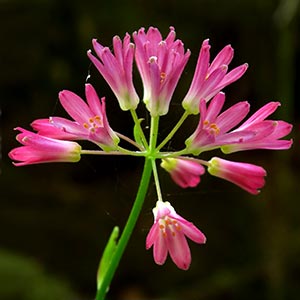Clintonia
Clintonia andrewsiana
beadlily, bluebead, clintonia
Andrew's clintonia, blue-bead lily, red clintonia, redwood clintonia
basal 2–6, arising from rhizome crown, sessile, sheathing, hyaline, chaffy in age;
cauline petiolate, blade with central vein prominent basally, obovate to oblanceolate, weakly villous-pubescent, base attenuate to cuneate, margins entire, apex acute to abruptly short-acuminate, often mucronate.
4–6;
blade dark green, oblanceolate to broadly elliptic, 20–35 × 5–15 cm.
terminal, in short racemes or umbellike clusters, 1–45-flowered, bracteate;
bracts foliaceous or linear.
in terminal, umbel-like clusters, 1–3(–5) lateral clusters usually present, 20–45-flowered;
bracts 1–3(–5), foliaceous.
tepals caducous, 6, distinct, obovate to narrowly oblanceolate, nectaries present, sometimes obscure;
stamens inserted at perianth base;
filaments dilated, basally pubescent;
anthers oblong-obovate to oblong-linear, semiversatile, extrorse;
ovary superior, 2-locular [3-locular], ovoid to subcylindrical, glabrous, ovules 2–10 per locule;
style columnar, compressed laterally;
stigmas weakly 2-lobed [3-lobed];
pedicels unequal, elongate and ascending with age.
tepals deep claret red, narrowly oblong to oblanceolate, 10–18 × 3–3.7 mm;
filaments 7–10 mm;
anthers oblong, 1.8–2.8 mm.
baccate, metallic blue to black, 4–30-seeded, ellipsoid to ovoid, smooth.
blue to bluish black, ovoid, 10–30-seeded, 8–12 mm.
shiny brown, round abaxially, angled with 2 or 3 faces.
3–4 mm.
= 7.
= 28.
Clintonia
Clintonia andrewsiana
Species 5 (4 in the flora).
Eastern and western Native Americans used Clintonia as an eye and heart medicine, as well as a dermatological and gynecological aid (D. E. Moerman 1986).
The North American Clintonia species have bicarpellate ovaries by reduction (F. H. Utech 1973) and reticulate pollen, in contrast to the typical liliaceous tricarpellate ovaries and gemmate pollen that occur in the eastern Asian C. udensis (M. Takahashi and K. Sohma 1982; V. N. Kosenko 1991). The genus has a unique type of megasporogenesis, the “Clintonia-type” (A. N. Pahuja and V. Kumar 1971; F. H. Smith 1943; R. W. Smith 1911; R. I. Walker 1944), in which there is a selective elimination of genomes (heterotypic vs. homotypic divisions) before double fertilization, resulting in genetically identical diploid embryo and diploid endosperm nuclei. Such derived megasporogenesis is equivalent to female self-fertilization (pseudogamy).
Counts of 2n = 28 are known in all Clintonia species except for a recently discovered sympatric diploid cytotype (2n = 14) in C. udensis (Li S. F. and Chang Z. Y. 1996; Li S. F. et al. 1996). It appears therefore that the Clintonia karyotype has an ancient allopolyploid origin and that the generic base number should be viewed as x = 7 and not x = 14. Based on these karyological data, an early eastern Asian and North American divergence with speciation and polyploidization occurring in North America is postulated.
M. N. Tamura (1998c) included Medeola and Clintonia in the tribe Medeoloideae within a narrowly defined Liliaceae, and molecular analysis supports the association of those two genera (K. Hayashi et al. 1998, 2001; M. F. Fay and M. W. Chase 2000).
(Discussion copyrighted by Flora of North America; reprinted with permission.)
1. Inflorescences 1–8(–10)-flowered, in short, terminal racemes. | → 2 |
1. Inflorescences 10–45-flowered, in terminal and/or lateral, umbel-like clusters. | → 2 |
2. Plants 1.5–2.5 dm; inflorescences 1- or 2-flowered; tepals creamy white, 18–25 mm; anthers 3.5–5.5 mm; w North America. | C. uniflora |
2. Plants 2–5 dm; inflorescences 3–8(–10)-flowered, in short, terminal racemes; tepals yellow to yellowish green, 12–16 mm; anthers 2–3.5 mm; e North America. | C. borealis |
3. Inflorescences 20–45-flowered, lateral clusters usually present; tepals claret red, narrowly oblong to oblanceolate, 10–18 mm; berries blue to bluish black, 10–30-seeded; California, Oregon. | C. andrewsiana |
3. Inflorescences 10–25(–30)-flowered, in terminal clusters only; tepals white, often spotted purplish brown or green distally, ovoid-obovate, 5.5–8 mm; berries black, 2–4-seeded; e North America. | C. umbellulata |
